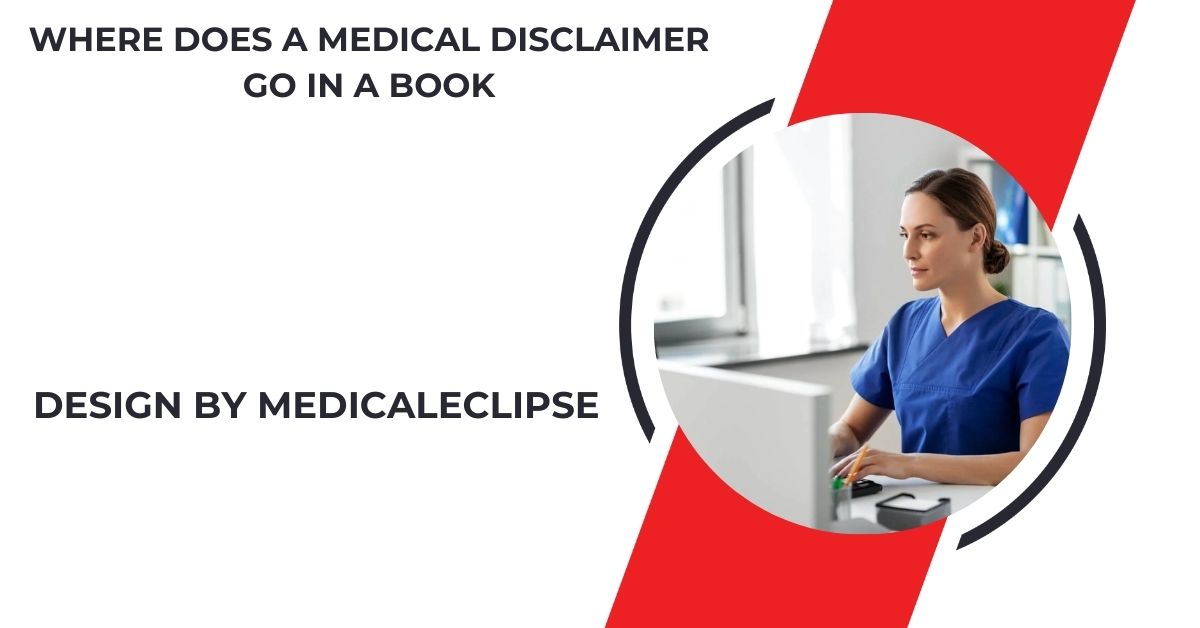A medical disclaimer should be placed prominently in a book, ideally before the table of contents, to inform readers about content limitations and legal protections.
This guide provides an in-depth look at the importance of medical disclaimers, best practices for placement, and tips for creating a comprehensive disclaimer.
Where Does a Medical Disclaimer Go in a Book?

Books covering topics like health, wellness, or any form of medical advice hold unique responsibilities for their authors. Medical disclaimers are essential in such works as they clarify the book’s purpose, set boundaries, and serve as legal safeguards. If you’re an author or publisher, knowing where to place a medical disclaimer and how to word it effectively can enhance your book’s credibility and protect against potential liability.
Why a Medical Disclaimer Is Important in Books with Health-Related Content?
Medical disclaimers are more than just formalities—they clarify that readers should not rely solely on the book’s information for medical decisions. Here are some of the core reasons why a medical disclaimer is essential:
- Legal Protection: A disclaimer provides a defense if a reader misinterprets or misuses the information in your book, which could otherwise lead to legal claims against you as the author.
- Managing Reader Expectations: A medical disclaimer informs readers that your book serves as guidance, not a professional medical service. This helps readers understand the limits of the advice they’re getting and prevents misinterpretation.
- Promoting Responsible Use of Content: Readers can be encouraged to seek medical professionals for personal health needs, supporting safe and informed decision-making.
- Credibility and Transparency: Including a clear disclaimer demonstrates integrity, showing readers that you respect their well-being and recognize the importance of professional healthcare.
In short, a medical disclaimer is a necessary addition to any book discussing health topics, and placement matters for its visibility and effectiveness.
Optimal Placement Options for a Medical Disclaimer in a Book:
Choosing the right placement for a disclaimer can impact its effectiveness. It’s important to place it in a spot where readers will be likely to see it, ideally before they begin following any advice. Here are several strategic options:
Also Read: How Many Students In Ut Tylers Medical Class – UT Tyler Medical Class Size!
Before the Table of Contents:
Positioning the disclaimer before the table of contents places it in an upfront, highly visible location. This ensures readers see the disclaimer as one of the first elements, reinforcing its importance.
- Pros: Offers immediate visibility; readers are aware of the limitations of the information even before delving into the content.
- Cons: For some readers, this placement may feel abrupt, especially if the book has multiple disclaimers (such as copyright or legal disclaimers) upfront.
On a Standalone Page in the Front Matter:
Another common choice is placing the medical disclaimer on a dedicated page within the book’s front matter—often following the title page and copyright notice but before the table of contents. This dedicated page format makes the disclaimer easy to locate and gives it prominence.
- Pros: Sets the tone and gives the disclaimer the attention it deserves. Readers are less likely to overlook it.
- Cons: May feel repetitive if there are multiple disclaimers, but this is typically offset by the importance of a clear medical disclaimer.
Integrated into the Preface or Introduction:

For books that have a conversational or explanatory preface, adding a medical disclaimer in this section can feel natural and approachable. You can acknowledge the book’s limitations as part of a friendly introduction to your readers.
- Pros: Fits seamlessly within the book’s introductory framework, making the disclaimer feel conversational.
- Cons: May be less effective as a standalone statement if too integrated; some readers may skip the preface.
At the Start of Relevant Chapters or Sections:
If the health book has specific sections or chapters that discuss more sensitive or potentially risky topics, placing disclaimers at the beginning of these chapters can work well. This approach reminds readers when caution is needed and serves as a secondary disclaimer.
- Pros: Contextualizes the disclaimer to relevant sections, keeping it top-of-mind when discussing critical content.
- Cons: Overuse could feel repetitive and disrupt the flow, especially in books with multiple sections requiring disclaimers.
In the Back Matter or Appendix:
For books where medical advice is secondary or supplementary, placing the disclaimer in the back matter (appendix or endnotes) can be appropriate. In this placement, a disclaimer may be referenced in the table of contents to ensure readers can locate it.
- Pros: Ideal for books that don’t prioritize medical content; less intrusive for readers.
- Cons: Lower visibility; readers may miss it unless explicitly directed to it in the table of contents.
Also Read: Can I Qualify For Medicaid If I Have Retirement Accounts – Medicaid and Retirement Accounts!
Crafting an Effective Medical Disclaimer:
When writing a disclaimer, clarity and directness are essential. Here are some best practices to ensure that your disclaimer is understandable, legally sound, and effective:
- Keep the Language Clear and Accessible: Avoid jargon or complex legal language. Use straightforward language that the average reader can easily understand.
- Emphasize that the Book is Not Medical Advice: Explicitly state that the book’s content is for informational purposes and is not a substitute for professional medical advice, diagnosis, or treatment.
- Encourage Readers to Consult Healthcare Providers: A good disclaimer advises readers to seek qualified medical advice for personal concerns or questions about their health.
- Limit Liability: Clearly outline that you (the author) and the publisher bear no responsibility for any consequences resulting from actions taken by readers based on the information in the book.
- Reinforce with Legal Review: For additional protection, have your disclaimer reviewed by a legal professional. This is especially valuable if your book addresses potentially controversial or sensitive health topics.
Sample Medical Disclaimer:
Here’s a sample disclaimer that authors can adapt:
“Medical Disclaimer: This book is intended for informational purposes only. The content provided here is not intended as medical advice, diagnosis, or treatment. Readers should not rely on this information as a substitute for professional medical care. The author and publisher are not responsible for any adverse effects or outcomes resulting from the use or application of the information provided in this book. Always consult a qualified healthcare provider with questions regarding any medical condition or treatment.”
FAQ’s
1. Why is a medical disclaimer important?
A medical disclaimer informs readers that the book’s content is for informational purposes only and not a substitute for professional medical advice, protecting authors from legal liability.
2. Where should the medical disclaimer be placed?
It should be placed prominently, ideally before the table of contents or on a standalone page in the front matter for maximum visibility.
3. Do all health-related books need a medical disclaimer?
Yes, any book that discusses health, wellness, or medical topics should include a disclaimer to clarify its intent.
4. Can I customize the medical disclaimer?
Yes, the disclaimer should be tailored to reflect the specific content and potential risks associated with your book.
5. Is it advisable to have a legal review of the disclaimer?
While not mandatory, having a legal review is recommended to ensure the disclaimer is comprehensive and protects against liability.
Conclusion
In conclusion, a medical disclaimer is a vital component of any health-related book, ensuring that readers understand the limitations of the information provided. By clearly stating that the content is for informational purposes only and encouraging consultation with healthcare professionals, you protect yourself legally and promote responsible use of the material. Thoughtful placement and wording of the disclaimer foster trust and credibility with your audience.

Leave a Reply